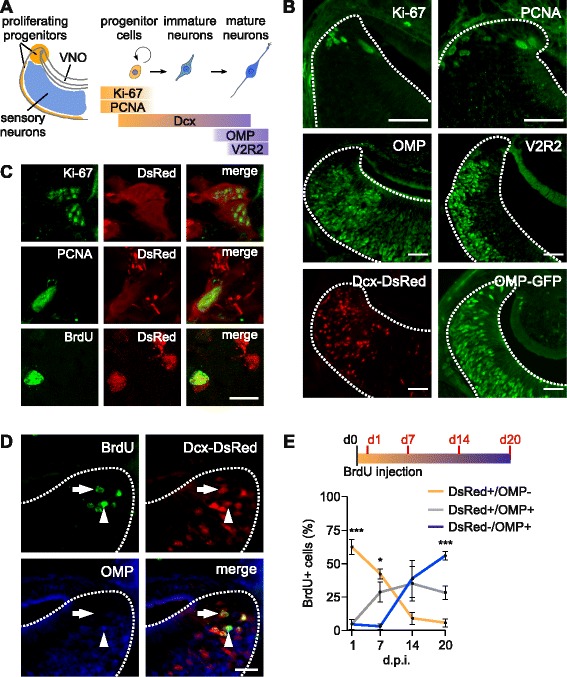Fig. 1.

Neurogenesis and development of vomeronasal sensory neurons (VSNs). (a) Schematic of VSN maturation and markers used. Ki-67/proliferating cell nuclear antigen (PCNA)-positive proliferating progenitors in the marginal zones of the vomeronasal organ (VNO; orange) develop to immature doublecortin (Dcx)-expressing neurons and mature VSNs in the central VNO (blue) expressing olfactory marker protein (OMP) and vomeronasal receptors (VRs). Ki-67 is a nuclear antigen expressed during the whole cell cycle except at G0. PCNA participates in DNA synthesis. Dcx is a microtubule-associated protein expressed in immature neurons. OMP is expressed in mature olfactory and vomeronasal sensory neurons. V2R2 antibody recognizes family-C V2Rs expressed in most mature basal VNO neurons. (b) Coronal VNO tissue slices labeled with antibodies against the early proliferation markers Ki-67 and PCNA (top panels) reveal expression on the VNO marginal zones, whereas in maturity, the markers OMP and V2R2 (center) localize on the center of the sensory epithelium on all or basal VSNs, respectively. Bottom panels: endogenous expression on OMP-GFP and Dcx-DsRed transgenic mice in the VNO. Dotted lines show the limits of the sensory epithelium. Scale bars, 50 μm. (c) Double-labeling of Ki-67, PCNA and BrdU (1 day post-injection) immunostainings (green) with Dcx-DsRed in individual cells of the VNO epithelial margins. Scale bar, 10 μm. (d) Triple-labeling with antibodies recognizing BrdU (green) and OMP (blue) with the DsRed (Red) on VNO coronal slices of Dcx-DsRed mice 14 days after injection with BrdU. Newborn VSNs can be identified in an early maturity stage by double labeling of BrdU and DsRed (arrow) and in a later stage by triple labeling of BrdU/DsRed/OMP (arrowhead). Dotted lines show the limits of the sensory epithelium. Scale bar, 25 μm. (e) Fate-mapping analysis of BrdU+ cells in the VNO epithelium quantified at 1, 7, 14 and 21 days post injection (d.p.i.) in VNO coronal slices of Dcx-DsRed mice immunolabelled with BrdU and OMP, as shown in (d). OMP+ cells increase, while DsRed+ and OMP– cells decrease over time. About 50 % of the newly generated cells reach a mature phenotype in 20 days. One-way ANOVA: F2,8 = 2.15–56.3; ***P <0.005 (1 d.p.i.; DsRed+/OMP– vs. DsRed+/OMP+ and DsRed–/OMP+), *P <0.05 (7 d.p.i.; DsRed–/OMP+ vs. DsRed+/OMP+ and DsRed+/OMP–), ***P <0.005 (20 d.p.i.; DsRed–/OMP+ vs. DsRed+/OMP– and DsRed+/OMP+), n = 3 mice per time point
